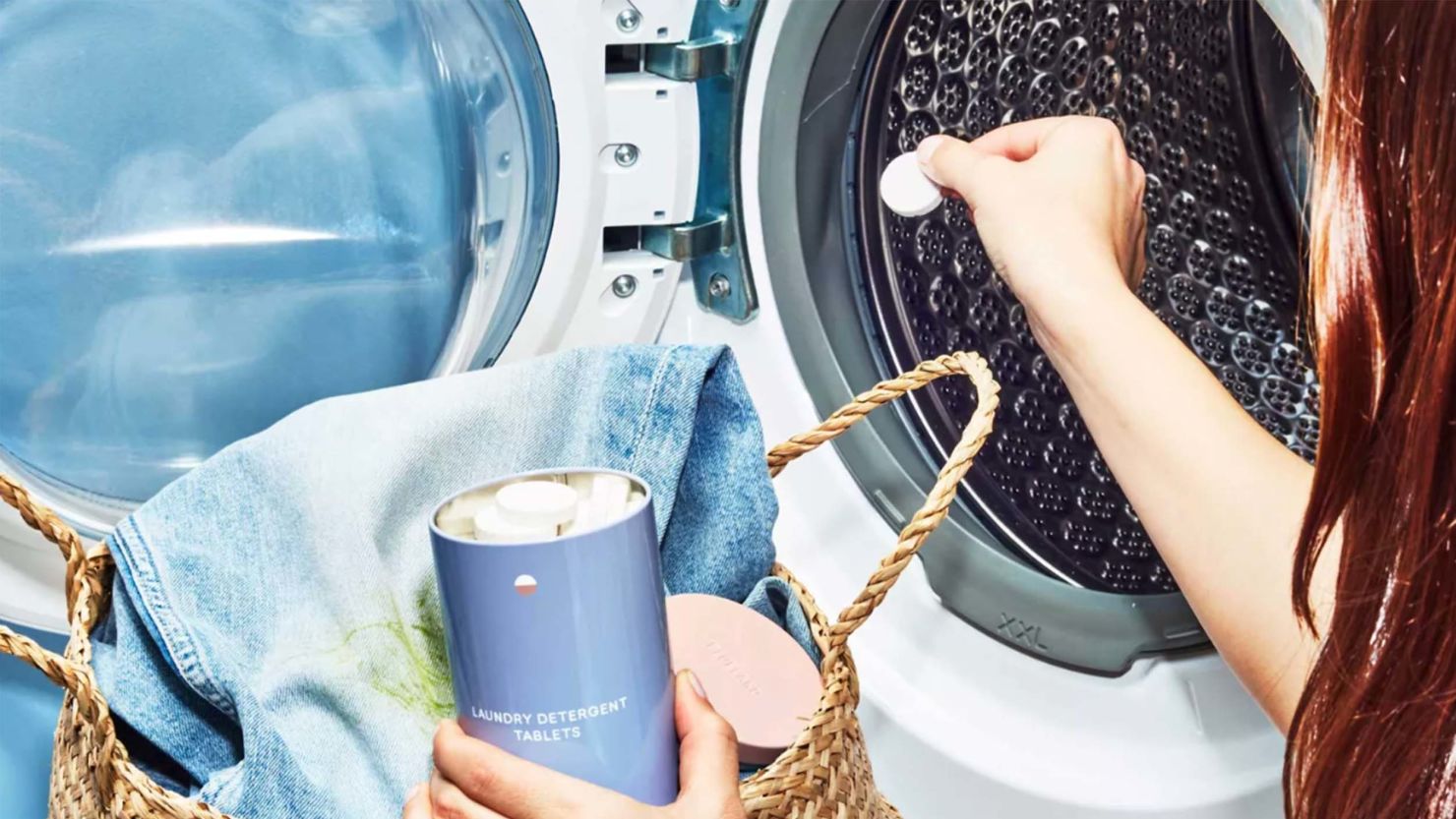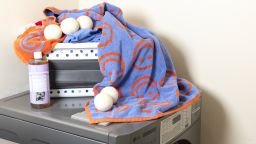Washing your laundry at home may not seem destructive, but the mundane chore leaves an environmental stain that won’t easily come out in the wash. Commonly used laundry detergents and fabric softeners contain toxic and carcinogenic chemicals that contaminate the air, pollute waterways and harm human health. According to the Environmental Working Group (EWG), 95% of wastewater samples contain chemical contaminants found in laundry products that can disrupt hormones, trigger asthma and threaten aquatic life. So, if you care about sustainable living at all, it’s vital that you learn how to do your laundry in a more environmentally friendly way.
But it can be confusing to determine which products are actually good for the earth versus those that greenwash the problem. To find out how to wash laundry sustainably, we delved into the best methods to reduce water and energy usage, combined with expert advice and eco-friendly products that will leave your clothes and the planet cleaner.
Laundry cleaning products explained
You have probably walked down the grocery store aisle of cleaning products and stared in overwhelming disbelief at the sea of brightly colored laundry detergents and fabric softeners in as many shapes and sizes as there are claims on the front of the packages. Instead of buying the detergent that’s on sale or defaulting to the brand you recognize, consider your options. Patric Richardson, the Laundry Evangelist and author of “Laundry Love: Finding Joy in a Common Chore,” believes that people can transform a tiresome chore into a mindful practice by taking stock of their purchases because “when we get mindful, we make better decisions,” he says.
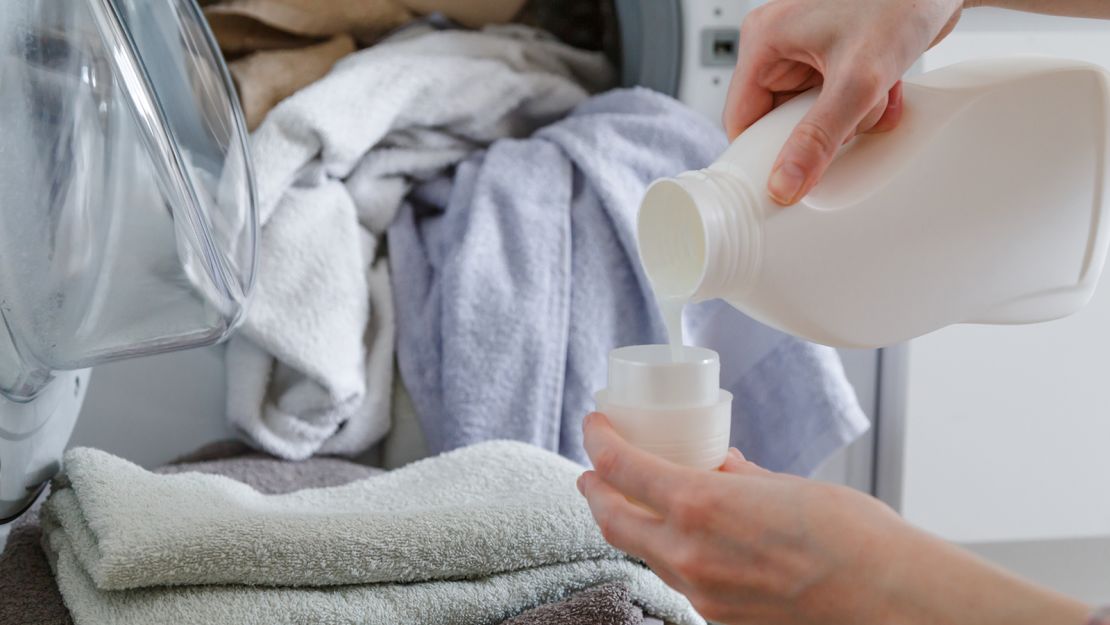
Traditional powdered formulas in cardboard boxes have been overrun by diluted liquid detergent in hard plastic jugs. Now there are also detergent pods, tablets and dissolvable strips that have innovated packaging and storage issues, but do they live up to their claims of safety, eco-friendliness and biodegradability? “Always be skeptical of sustainability buzzwords like plant-based, organic, green or eco, particularly when used by conventional big-name manufacturers,” says Corinna Williams, co-founder of Celsious, a sustainable garment-care business in Brooklyn. “These terms are not regulated and can be used by anyone.”
Companies aren’t required to list their ingredients on the product itself, so Williams suggests looking on the brand’s website for the full ingredient list and comparing the ingredients to environmental databases. She recommends checking products for accredited certifications through?EPA Safer Choice,?Made Safe?and third-party ratings like the?EWG’s verification system?to certify ingredients and environmental impact claims.
What’s inside
Conventional detergents and fabric softeners have been expertly engineered to tackle grime and stains and make clothes feel fluffy and smell like a field of wildflowers. But their?petroleum-based volatile organic compounds are environmental pollutants, irritants and carcinogens that pose a serious threat to ecological and public health.
There are thousands of?synthetic ingredients?in laundry care products such as phosphates (which have been banned from use), chemical fragrances and quaternary ammonium compounds that cause?respiratory problems?when inhaled,?pollute water systems?when they drain into public waterways and?disrupt local ecosystems.
Sustainable laundry products
When it comes to laundry products, it is therefore crucial to cut through the flashy marketing and bold claims. Instead, consider the ingredients, packaging and at-home application. Products listed below are prioritized for their fragrance-free formulas, transparent ingredients, zero-waste refills, metal packaging that recycles forever, and renewable and biodegradable materials. We chose formulas that have low water usage and clean your clothes effectively.
Debating between powdered and liquid detergent? Powder detergents are lightweight, don’t use as much storage and can be made into a concentrated paste to tackle stubborn stains. Unlike liquid formulas, detergent powders are often packaged in cardboard boxes that are recyclable and/or compostable. But it all depends on what you’re washing and how often, Williams explains. Because the cost per load is lower with powdered detergent, she prefers it for items that are washed regularly like towels, bedding and casual attire.
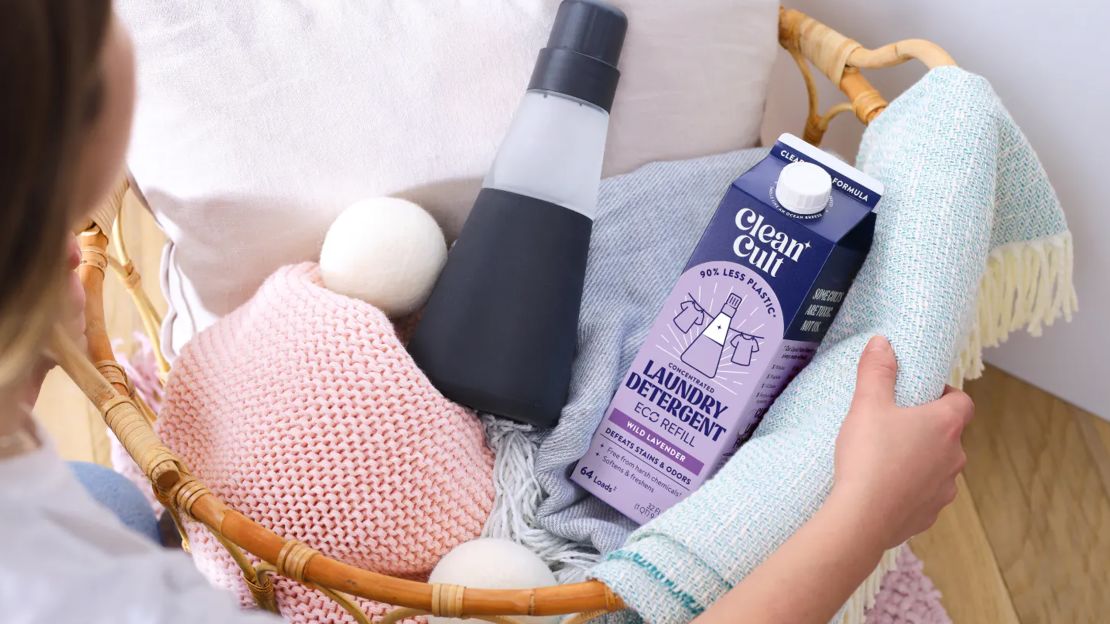
Gentle liquid detergents are more effective for delicate and sweat-wicking clothes, but the downside is they are water intensive to make, energy intensive to transport and often packaged in HDPE plastic, “only 30% of which gets recycled,” Williams says. “Water-based products also require preservatives to be shelf stable, sometimes [with] formaldehyde,?a known human carcinogen.”
If you drop off your laundry at a laundromat, you can still stick to eco-friendly practices, Williams assures. “Be specific about the washer and dryer temperatures you’d prefer to use. Many laundromats will also allow you to provide them with your own laundry care products. If you’d like them to use eco-friendly soap or white vinegar and/or dryer balls for softening, bring them along with any instruments for dosage (tablespoons for powder, small measuring cups for liquids).”
Nellie’s washing soda is a highly concentrated formula that dissolves in water. It’s packaged in a tin container and can be purchased as a bulk option in a plastic bucket.
Cleancult’s liquid laundry detergent is biodegradable and available in hypoallergenic scented or unscented formulas. It’s packaged in a refillable and recyclable paper carton and washes 64 loads, depending on soil levels and machine efficiency.
We've used Dropps for years and appreciate the company's commitment to sustainability. Case in point: Its concentrated laundry detergent pods use plant-based ingredients and skip artificial colors.
Blueland is miles ahead of traditional companies when it comes to sustainbility. This laundry essentials kit — you get detergent tablets, laundry boosters and dryer balls — forgoes single-use plastics and harmful ingredients like parabens and phthalates.
DIY laundry products
You likely already have household staples that are effective stain removers and garment fresheners hiding in plain sight in your home, such as vinegar, rubbing alcohol and even vodka (Richardson’s go-to fabric freshener). These solutions perform best when paired with nontoxic detergents, he advises, because conventional detergents leave a residue on clothes that makes it hard for gentler products to be effective.
Household cleaning recipes can be affordable alternatives to commercial products, but always research each ingredient and how it is being combined before you use a homemade product. When preparing a recipe, always wear a mask to limit inhalation of small dust particles in cleaning powders and wear gloves to protect your hands from potential skin irritation. Store cleaning supplies in a cool, dry place out of reach of children and pets.
Baking soda can be added to the wash cycle to brighten, deodorize and soften clothes. To add a scent to baking soda, include a few drops of your favorite essential oil.
Pure sodium percarbonate, or dry hydrogen peroxide, is a great non-chlorine bleach that’s more concentrated than OxiClean, so you don’t need to use as much of it. Look for it in package-free shops or buy in bulk to reduce packaging.
Distilled white vinegar is a powerful odor eliminator and fabric softener that is safe and effective for use on hand-washed fabrics and in washing machines when heavily diluted. Similarly to baking soda, you can infuse distilled vinegar with essential oils for fragrance.
Rubbing alcohol, or?isopropyl alcohol, is used widely as a disinfectant but is less known for its powers as an odor remover, fabric softener and solvent degreaser. Because it is a neutral solution, neither acidic nor basic, it is safe to use in washing machines.
Laundry products to avoid
Products on the market can make bold claims with little regulatory oversight to hold them accountable. Here’s what you can leave on the shelf, use sparingly and live better off without.
Fabric softeners and dryer sheets?don’t actually make clothes softer. You read that right. They are designed to be a cheap shortcut that coats fabric in?flammable lubricants and humectants?to create an unnatural feeling of softness rather than actually making clothes soft. Ultimately, this leads to fabric becoming less absorbent over time and actually traps dirt and stains in the clothes, according to Richardson in “Laundry Love.” Stains on clothing can get stuck between the layers of fabric softener that coat the inside and outside of the fabric, which makes it more difficult to remove stains and get clothes really clean. “It takes five to eight washes of not using fabric softener or dryer sheets to completely remove that layer of artificial softness from your clothes,” Richardson cautions.
Laundry detergent pods, sheets and strips attempt to conveniently reduce packaging, eliminate plastic and disappear down the drain as dissolvable bioplastic, but there is?mixed research?as to their true?biodegradability in wastewater treatment systems, and concern over the effects of even smaller microplastics entering waterways. The synthetic polymer that these pods are often made of is called polyvinyl alcohol (PVA and PVOH). While?studies in the past?have shown these films dissolve by at least 60% in less than 28 days,?one study?found that among three different common PVAs tested, the biodegradability was negligible.
You’ll also want to steer clear of borax, the popular household cleaner that touts its all-natural qualities and versatile cleaning capabilities. It has a?D rating?from EWG because it is a pesticide that can be poisonous to humans and animals. Borax is rated by the?Journal of Chemical Education?as highly toxic and harmful to the skin, eyes and respiratory system.
Chlorine bleach (sodium hypochlorite) is a readily available dilute liquid solution used to disinfect surfaces, brighten whites and erase stains, but it’s?toxic to human health?when it is inhaled, in contact with skin or mixed with other compounds. Use sparingly and store out of reach of children and pets, or substitute with non-chlorine oxygenated all-fabric bleach.
Basic laundry tips to cut energy and preserve clothes
When it comes to sustainable laundry practices, taking care of the clothes, towels and bedding you already have is as important as any product you pour into the washing machine. “You want to use products that are going to be safer and cleaner, but there’s also the bigger piece of sustainability, which is the resources in making our clothing,” Richardson says. “The better we take care of our clothing, the longer it lasts, and the better we’re using those resources.”
The textile industry produces a fifth of the world’s water pollution and uses thousands of carcinogenic chemicals to make textiles. Purchase used or sustainable clothing, and avoid sending worn-out garments to the landfill by preserving the clothes, linens and towels you already have with easy habit changes. Here are some important steps you can take to reduce water and energy consumption, extend the life of your clothes and save on the cost of laundry products.
Sniff, spot, sort and repair
If clothes aren’t visibly soiled, the sniff test can tell you whether they need to be laundered or if they can be worn again. Surprisingly, some fabrics like denim and wool only need to be washed a few times a year, and can be spot-treated for any small spills. “I only wash my sweaters when they’re truly dirty (meaning once a season for some),” writes Aja Barber in “Consumed: The Need for Collective Change: Colonialism, Climate Change, and Consumerism.” “Wool is naturally antibacterial on its own, because of the lanolin, so it doesn’t need a wash after every wear, especially if it doesn’t smell.”
Spot-treat stains soon after they happen to ensure that they can be removed from the fabric. “The sooner you treat a stain, the better your chances of having the stain come out in the wash,” Williams says. “Once a stain sets, you’re probably not going to want to wear the garment anymore, especially if the stain is located in a very visible area.” Having a stain stick on hand makes it easy to clean spills before they irreparably alter your clothes.

If a stain has you stumped, enlist help from Stain Solutions, a resource by the University of Illinois that breaks down the science of stain removal with quick tips to get rid of just about any spot, from deodorant stains to lighter fluid spills to sticky tree sap.
Don’t skimp on sorting laundry. Richardson advises separating clothing into five categories — lights, darks, cool colors, warm colors and athletic clothes — to avoid fabric dye bleeding into the water and ruining lighter fabrics. Empty pockets and wash garments inside out, advises cleaning expert Jolie Kerr, to reduce color fading and odor retention in clothing such as dark denim, sportswear and dark T-shirts. Wash delicate cloth like silk, lace and nylon separately from heavier fabric like cotton, denim and wool, either in a separate load or contained in a garment bag.
Mesh washing bags do more than just protect delicates. They reduce microplastics in the water, a precaution that is needed if you own synthetic blended fabrics. According to research by the European Environment Agency, 200,000 to 500,000 tons of microplastics enter the global marine environment per year due to fabric made from synthetic materials like polyester, rayon, spandex and acrylic. These synthetics shed tiny fibers that “can find a way into the water systems through washing,” Barber explains, noting how microplastics in water can eventually get into the human body. “If you are a pregnant person, they may even find a way into your placenta.” If you don’t want to deal with washing your laundry in mesh bags, you can attach an external filter to the side of any standard or high-efficiency machine at home to trap microfibers before they enter the water system.
To make your clothes last as long as possible, repair pieces that have holes, lost buttons, broken zippers and minor blemishes. The sashiko mending style of stitching hides mended rips and tears using patches that are stitched over with artful repetitive patterns; the stitching reinforces the durability of the mending. If you’re in over your head, don’t sweat it. Williams encourages taking your garments to an expert to have them mend the pieces for you. Items that cannot be repaired, like old T-shirts and hand towels, can be cut into rags for cleaning, and Richardson suggests donating old bath towels and bedding to your local animal shelter.
Work with your machine, not against it
How you load the washing machine affects your energy costs and water usage. Packing too many items into the washer causes overcrowding, which means clothes don’t get clean or properly rinsed, resulting in unnecessary additional cycles. Likewise, putting too few items in the washer wastes water and detergent. Newer machines are designed to be efficient, so water fills the drum based on the weight of the load inside. Washing machines are more efficient when they run at full capacity, so save up your dirty clothes and wash them in a few big loads versus several smaller loads.
As a rule of thumb, avoid hot temperatures that can cause shrinkage and heat damage, and skip long wash cycles that will wear your clothes down over time. Richardson points out that the energy savings of cold water are diminished if the cycle is twice as long or if the detergent doesn’t dissolve. “Look at what you’re doing to the clothes,” he says. “You’re shortening the life of the garment.” Washing machines constantly change out water, so a longer cycle means more water is used, which causes more wear and tear on your clothes. He advocates running short wash cycles of 30 minutes or less, using warm water to ensure activation of laundry soap and powdered detergents. Always check the instructions on your clothing tags and adjust water temperatures and cycles accordingly. For washers that are optimized for liquid detergent, you can dissolve powder detergents in warm water before adding to the detergent drawer or pouring directly into the drum.
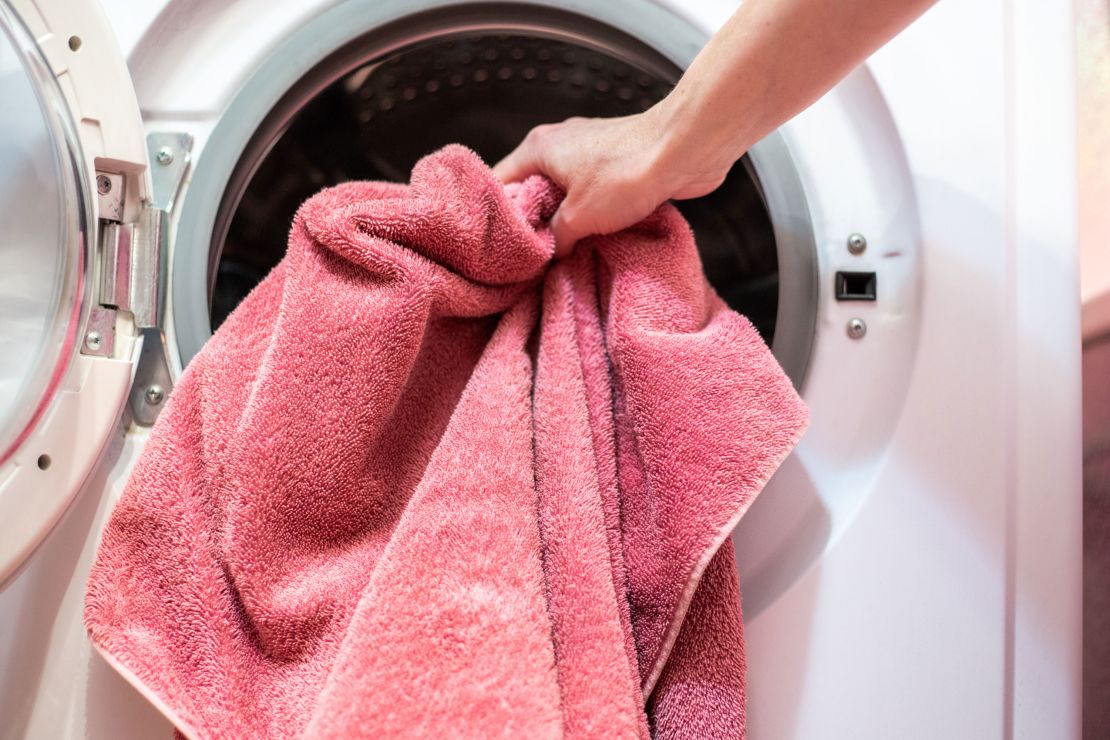
Measure detergent correctly. If you’re accustomed to unconcentrated liquid detergents that use a cup measurement, it can be hard to adjust to ultra-concentrated brands that call for 1 tablespoon or less. Resist the temptation to add more. “It’s like when you buy expensive shampoo versus cheap shampoo. You find out quickly that the expensive shampoo is very concentrated, so you don’t need that much,” Richardson says. “You’re basically not paying for water.” Following the instructions allows you to conserve detergent, save money and ensure that all of the soap is thoroughly rinsed off of your laundry.
If you go the DIY route and make your own liquid or powder detergent blend, you may need a period of trial and error to find the right amount for your washer and soil levels. Always start with a modest amount and work your way up.
Another tip our experts emphasized is that fragrance isn’t the marker of cleanliness. “The biggest misconception about garment care is that clean equals fragrant,” Williams says. “Clean laundry should smell like nothing! Not odorous, not heavily perfumed — it exists somewhere in the middle, in a fresh and neutral zone.” Marketing peddles the idea that strong artificial scents mean clothes are really clean, but it’s something that consumers should question, Williams says. “Synthetic fragrances found in detergents, fabric softeners, scent boosters and dryer sheets can contain skin and respiratory irritants, endocrine disrupters and carcinogens, among other things,” she explains. “Suffice to say, these overpowering synthetic fragrances are not good for your health or the environment.”
The Guppyfriend Washing Bag claims to filter out microplastics in every load. And in our testing, the Guppyfriend delivered, protecting our clothes from wear and catching microfibers.
Reducing microfiber pollution, this filter traps fibers from less than 20 microns to 5 millimeters and is compatible with HE and standard washing machines. “We’re the first (and currently only) North American retailer of these external filters,” Williams says.
This beginner's sewing kit has everything you need to make simple repairs to your clothing, including 30 needles and 16 threads. It also comes in a convenient case for easy storage.
